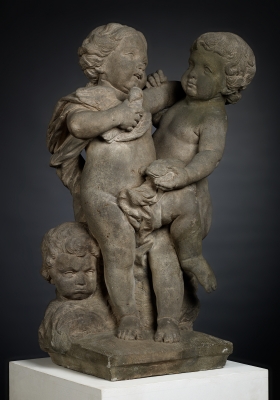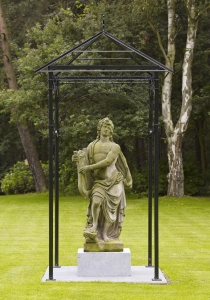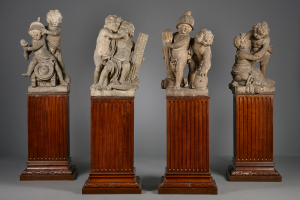Dutch Louis XIV Sandstone Garden Sculpture
Dutch Louis XIV Sandstone Garden Sculpture
This sandstone sculpture of cherubs with attributes is a typical example of a garden statue from the Northern Netherlands of the early 18th century. We know of no maker of this unsigned sculpture. Depictions with putti were very popular in the beginning of the 18th century. Sculptors like the Van Logterens and De Baurscheits made various group images of children. This garden statue originates from their proximity. Two similar unsigned statues in the Rijksmuseum were initially attributed to Jacob Vennekool, a sculptor that worked in the environment of the Van Logterens. P.M. Fischer, who performed a study on the Van Logterens, however, believes these groups to be made by Baurscheit.
The subject of the sculpture at hand is difficult to establish. The various animals held by the putti convey conflicting messages. The dove personifies peace or Venus (and therewith lust). The salamander represents eternity or the virtuous person that is not digested by the fire of lust.
The owl depicts wisdom or, according to the common knowledge of the 17th and 18th century, blindness and foolishness because of its poor abilities to see in the daylight.
Given the amiable posture of the putti towards each other, it is likely that the one with the dove stands for love and lust and the one with the salamander stands for virtue and resistance to temptation. The owl, depicting blindness, suggests that even the most virtuous are prone to seduction.
Literature:
P.M. Fischer, Ignatius en Jan van Logteren beeldhouwers en stuckunstenaars in het Amsterdam van de 18de eeuw, Alphen aan de Rijn 2005, p. 38-40 over de gebroeders Vennecool
J. Leeuwenberg,W. Halsema-Kubes, Beeldhouwkunst in het Rijksmuseum, ’s Gravenhage 1973, p. 263,264, nr. 357
- Period
- ca. 1715
- Material
- sandstone
- Dimensions
- 81 cm
Global shipping available









